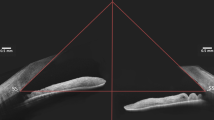Abstract
Purpose
Primary adult glaucomas that have an occludable angle with peripheral anterior synechiae which are too few to account for the chronically raised IOP, or the glaucomatous optic neuropathy, do not fit the definition of either POAG or PACG and can be considered as combined mechanism glaucoma (CMG). We aimed to compare the clinical features and anatomical parameters of combined mechanism glaucoma with age, sex, and refraction-matched POAG and chronic PACG eyes.
Methods
Consecutive adult patients with definitive optic nerve head and perimetric changes of glaucoma were screened at a tertiary care center. All glaucomatous eyes having an IOP > 22 mmHg on at least three separate occasions and glaucomatous optic neuropathy consistent with moderate visual field loss in the eye were divided as POAG, PACG, and CMG. Eyes with occludable angles having < 90° of goniosynechiae were diagnosed as CMG. A detailed clinical examination, ocular biometry, and ASOCT were performed in the better eye of all individuals.
Results
A total of 93 patients with similar visual field index or pattern standard deviation on perimetry were evaluated: 32 POAG, 31 CMG, and 30 PACG. The mean anterior chamber depth was 3.47 ± 0.37 mm in POAG, 2.81 ± 0.32 mm in PACG, and 3.06 ± 0.26 mm in CMG (p < 0.0001). Mean lens thickness was 4.22 ± 0.27 mm in POAG, 4.53 ± 0.35 mm in PACG, and 4.44 ± 0.29 mm in CMG (p = 0.0004). Iridotrabecular contact on ASOCT was nil in POAG, a mean of 87.60 ± 12.802% in PACG eyes, and 15.23 ± 14.19% in CMG eyes, p < 0.0001. CMG was similar to PACG in terms of corneal diameters and lens thickness and had an axial length in between PACG and POAG. On ASOCT, all parameters had highest values in POAG eyes and the least in PACG eyes, with CMG eyes having values in between the other two groups, p value of < 0.0001 between each group for all parameters.
Conclusion
This study has demonstrated significantly different anatomical parameters in eyes with CMG, in addition to the differences on gonioscopy and iridotrabecular contact, indicating that CMG is discernibly dissimilar to PACG and POAG.






Similar content being viewed by others
References
Foster PJ, Aung T, Nolan WP et al (2004) Defining “occludable” angles in population surveys: drainage angle width, peripheral anterior synechiae, and glaucomatous optic neuropathy in east Asian people. Br J Ophthalmol 88:486–490
Hyams SW, Keroub C, Pokotilo E (1977) Mixed glaucoma. Br J Ophthalmol 61:105–106
Hyams SW, Neumann E (1969) Congenital microcoria and combined mechanism glaucoma. Am J Ophthalmol 68:326–327
International Glaucoma Review.(2018) http://www.e-igr.com/MR/index.php?issue=43&MRid=79. Accessed 17 Jan 2018
Ferguson JJ, Randall OS (1986) Systolic, diastolic, and combined hypertension. Differences between groups. Arch Intern Med 146:1090–1093
Sihota R, Goyal A, Kaur J et al (2012) Scanning electron microscopy of the trabecular meshwork: understanding the pathogenesis of primary angle closure glaucoma. Indian J Ophthalmol 60:183–188. https://doi.org/10.4103/0301-4738.95868
Sihota R, Lakshmaiah NC, Walia KB et al (2001) The trabecular meshwork in acute and chronic angle closure glaucoma. Indian J Ophthalmol 49:255–259
Hamanaka T, Kasahara K, Takemura T (2011) Histopathology of the trabecular meshwork and Schlemm’s canal in primary angle-closure glaucoma. Invest Ophthalmol Vis Sci 52:8849–8861. https://doi.org/10.1167/iovs.11-7591
Lee JY, Kim YY, Jung HR (2006) Distribution and characteristics of peripheral anterior synechiae in primary angle-closure glaucoma. Korean J Ophthalmol 20:104–108. https://doi.org/10.3341/kjo.2006.20.2.104
Choi JS, Kim YY (2004) Relationship between the extent of peripheral anterior synechiae and the severity of visual field defects in primary angle-closure glaucoma. Korean J Ophthalmol 18:100–105. https://doi.org/10.3341/kjo.2004.18.2.100
Sihota R, Lakshmaiah NC, Agarwal HC et al (2000) Ocular parameters in the subgroups of angle closure glaucoma. Clin Exp Ophthalmol 28:253–258
George R, Paul PG, Baskaran M et al (2003) Ocular biometry in occludable angles and angle closure glaucoma: a population based survey. Br J Ophthalmol 87:399–402
Nongpiur ME, He M, Amerasinghe N et al (2011) Lens vault, thickness, and position in Chinese subjects with angle closure. Ophthalmology 118:474–479. https://doi.org/10.1016/j.ophtha.2010.07.025
Marchini G, Pagliarusco A, Toscano A et al (1998) Ultrasound biomicroscopic and conventional ultrasonographic study of ocular dimensions in primary angle-closure glaucoma. Ophthalmology 105:2091–2098. https://doi.org/10.1016/S0161-6420(98)91132-0
Saxena S, Agrawal PK, Pratap VB, Nath R (1993) Anterior chamber depth and lens thickness in primary angle-closure glaucoma : a case-control study. Indian J Ophthalmol 41:71
Ali N, Wajid SA, Saeed N, Khan MD (2007) The Relative Frequency and Risk Factors of Primary Open Angle Glaucoma and Angle Closure Glaucoma. Pak J Ophthalmol 23(3):117
Guzman CP, Gong T, Nongpiur ME et al (2013) Anterior segment optical coherence tomography parameters in subtypes of primary angle closure. Invest Ophthalmol Vis Sci 54:5281–5286. https://doi.org/10.1167/iovs.13-12285
Baskaran M, Iyer JV, Narayanaswamy AK et al (2015) Anterior segment imaging predicts incident Gonioscopic angle closure. Ophthalmology 122:2380–2384. https://doi.org/10.1016/j.ophtha.2015.07.030
Abrams JD (1961) Mixed glaucoma. Br J Ophthalmol 45(7):503–510
Narayanaswamy A, Vijaya L, Shantha B et al (2004) Anterior chamber angle assessment using gonioscopy and ultrasound biomicroscopy. Jpn J Ophthalmol 48:44–49. https://doi.org/10.1007/s10384-003-0004-4
Sihota R (2011) An Indian perspective on primary angle closure and glaucoma. Indian J Ophthalmol 59(Suppl):S76–S81. https://doi.org/10.4103/0301-4738.73687
Author information
Authors and Affiliations
Corresponding author
Ethics declarations
Conflict of interest
The authors declare that they have no conflict of interest.
Ethical approval
All procedures performed in studies involving human participants were in accordance with the ethical standards of the institutional and/or national research committee and with the 1964 Helsinki declaration and its later amendments or comparable ethical standards.
Informed consent
Informed consent was obtained from all individual participants included in the study.
Additional information
This paper has not been published elsewhere.
Rights and permissions
About this article
Cite this article
Sihota, R., Kumar, S., Sidhu, T. et al. Is combined mechanism glaucoma a distinct entity?. Graefes Arch Clin Exp Ophthalmol 256, 1961–1969 (2018). https://doi.org/10.1007/s00417-018-4050-5
Received:
Revised:
Accepted:
Published:
Issue Date:
DOI: https://doi.org/10.1007/s00417-018-4050-5




